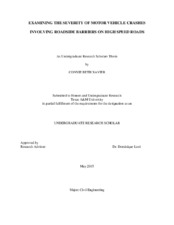| dc.creator | Xavier, Connie Beth | |
| dc.date.accessioned | 2015-06-30T14:02:34Z | |
| dc.date.available | 2015-06-30T14:02:34Z | |
| dc.date.created | 2015-05 | |
| dc.date.issued | 2014-09-08 | |
| dc.date.submitted | May 2015 | |
| dc.identifier.uri | https://hdl.handle.net/1969.1/154494 | |
| dc.description.abstract | With the implementation of posted speed limits greater than 75 mph in some states across the nation, there is an increasing interest among the roadside safety research community regarding the relevance of existing testing criteria used to evaluate the effectiveness of roadside safety barriers that are placed on such roads. Current crash test guidelines are contained in the Manual for Assessing Safety Hardware (MASH), which defines 62 mph being the 85th percentile impact speed for high speed roads. A crash data analysis of state highways and interstates in Texas with posted speed limits of 70, 75, 80, and 85 mph was performed to investigate whether MASH’s current test guidelines are applicable for roadside safety appurtenances placed on roads with posted speed limits greater than 75 mph. A representative sample of real-world, single-vehicle, run-off-road crashes involving longitudinal barriers as the first harmful event for years 2010 - 2013 was extracted from the Texas Department of Transportation’s (TxDOT) CRIS crash database. The need for a higher testing impact speed was investigated by determining whether the injury severity factor significantly increased as the posted speed limit increased for real-world vehicle accidents against longitudinal roadside safety barriers designed for 62 mph oblique impacts. As posted speeds continue to rise, it is important to know that the structural integrity of safety barriers is being tested at representative speed levels of real-world data since it has a direct impact on human life. At the 5% significance level, the fatal and incapacitating injury severity percentage was not statistically different between 70 mph and ≥ 80 mph for years 2010 – 2013. However, the combined crash data for all four years did show an increase and statistical significance between the percentages at the 5% level. This suggests that the 85th percentile impact speed for real-world crashes occurring on posted speed limit roads of ≥ 80 mph could be higher and that future work could support this finding. Future work, including looking at data for more years once they become available and the reconstruction of crashes to find actual impact speed, would provide a more conclusive statement. | en |
| dc.format.mimetype | application/pdf | |
| dc.subject | Transportation engineering, traffic engineering, roadside safety, longitudinal barriers, barrier, high speed road, crash severity, kabco, statistical analysis, confidence interval. motor vehicle crashes, injury severity | en |
| dc.title | Examining the Severity of Motor Vehicle Crashes Involving Roadside Barriers on High Speed Roads | en |
| dc.type | Thesis | en |
| thesis.degree.department | Civil Engineering | en |
| thesis.degree.discipline | Civil Engineering | en |
| thesis.degree.grantor | Honors and Undergraduate Research | en |
| dc.contributor.committeeMember | Lord, Dominique | |
| dc.type.material | text | en |
| dc.date.updated | 2015-06-30T14:02:35Z | |


